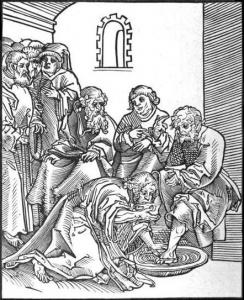 Two enacted parables worth thinking about during Holy Week.
Two enacted parables worth thinking about during Holy Week.
Last Sunday I turned from the Big Questions to focus on two clips from N. T. Wright’s visit to Cincinnati dealing with the intentional acts of Jesus during Holy Week leading up to his crucifixion and resurrection. Every act of Jesus we have recorded for us in the Gospels displays his intention and vocation. He often enacted parables as well as telling them. No where is this more apparent than in two scenes in John’s version of the events leading up to Good Friday. The first is the triumphal entry into Jerusalem, humble on the colt of a donkey.
Rejoice greatly, Daughter Zion!
Shout, Daughter Jerusalem!
See, your king comes to you,
righteous and victorious,
lowly and riding on a donkey,
on a colt, the foal of a donkey.
I will take away the chariots from Ephraim
and the warhorses from Jerusalem,
and the battle bow will be broken.
He will proclaim peace to the nations.
His rule will extend from sea to sea
and from the River to the ends of the earth. (Zech. 9:9-10)
The picture above by William Brassey Hole (1846-1917) tells the story quite well. There is more to this painting than most on the triumphal entry.
The question is simple. When Jesus entered Jerusalem on Palm Sunday, was he acting intentionally? (The clip should start at 38:36 and the relevant portion is just over 3 minutes long.)
The short answer is yes – but Wright goes on:
When Judas Maccabeus surprisingly defeated the Syrians in 164 BC and cleansed the temple, they came into Jerusalem waving palm branches. They are cleansing the temple, this is a celebration. This is all about a new Israel. At last, if we cleanse the temple and if we have a true king, then God will come back at last and dwell properly in the temple and we’ll never have to have this kind of stupid pagan stuff coming again. Now Jesus … chose Passover, that’s a really interesting phenomenon … according to John’s gospel Jesus was to and forth from Jerusalem for all the major festivals … If Jesus is going to die for the sins of the world, which moment in the Jewish calendar might he have chosen? Day of atonement, no brainer. No he doesn’t, he chooses Passover because more fundamental is the rescue, the rescue from the Pharaoh, the rescue from Egypt, the crossing of the Red Sea and the whole narrative of Exodus and Passover. And Jesus is deliberately reenacting that narrative through the lens of Zechariah chapter 9. Your king comes to you humble and riding on … a colt, the foal of a donkey. And the symbolism with the scriptural echoes is so typical of how lots of Jews thought and acted. But particularly how Jesus himself thought and acted. So many of his parables are full of biblical echoes which are about: this is how the kingdom of God comes, even though it’s surprising. So yes, it is deeply intentional but also kind of quizzical and paradoxical and forces people to think, and forces people into an awkward position where they have to make some decisions too. So yeah, when I was younger I just thought, so OK Jesus found a donkey and rode into Jerusalem. That’s what you do. But no, people didn’t do that … This is a very carefully staged piece of theologically motivated street theater. And it works like that. And Jesus knew exactly what buttons he was pressing and what was going to happen.
The second enacted parable a few days later is another act of humility, this time an enacted parable of both humility and service. John relates an episode not included by the other three gospel writers where Jesus washes the feet of his disciples. This clip comes from a lecture Wright gave during his visit to Cincinnati. It should start at 27 minutes and the relevant section lasts just over 5 minutes.
 The woodcut to the right is by Lucas Cranach the Elder (1472-1553). The key part of the clip is below (the whole is well worth the time as well):
The woodcut to the right is by Lucas Cranach the Elder (1472-1553). The key part of the clip is below (the whole is well worth the time as well):
Within the gospel’s recounting of that ultimate Passover, one scene stands out with special poignancy and power. John’s gospel displays deft artistry and fathomless theology throughout, but especially in the foot washing scene in John chapter 13; where in a few lines, we glimpse a tableau which is both intimate and touching and scary and dangerous. Having begun his gospel as John does with the all creative Word becoming flesh and revealing God’s glory, John begins the shorter second half of his gospel with an acted parable of the same thing. Jesus removes his outer garments and kneels down to wash the disciples’ feet, thereby summing up all that is to come in this act of divine humility, of loving redemption, of cleansing for service. For John, as indeed throughout the New Testament, Jesus vocation to rescue the world from its plight and in so doing to reveal the divine glory in action is focused and symbolized and encoded in an action simultaneously dramatic, fraught with cosmic significance. That’s how John wants you to read it. But also gentle and tender with human emotion. …
If you want to understand the great mysteries of Christian theology, of trinity and incarnation, and atonement itself, you could do worse than spend time with this scene, where the cosmic majesty of God meets the tender intimacy of Jesus washing his disciples’ feet. And John 13 begins by saying, having loved his own who were in the world, Jesus loved them to the end, to the uttermost. Here we see what it means. God so loved the world that he gave his only son. A love at once powerful and humble, sovereign and sensitive. And as always Jesus surprises his followers. … This is already a wonderful image of whole person washing of the gospel itself needing only the regular smaller scale washing of dusty feet. But like everything else in John’s gospel it is deliberately leading the eye up to the great saving act to come, in which the filth and mire of the centuries will be washed away in the torrent of water and blood. See from his head, his hands, his feet, sorrow and love flow mingling down.
Jesus then resumes his garments and explains the surface layer of meaning, as I have done this to you, you should do it for one another, which also points forward to the ministries of the gospel unleashed in John 20, as the father sent me so I send you. … The theology of the cross is ultimately only complete when it issues in the foot washing fruit bearing and world transforming mission of Jesus’ followers. It is a one-off. Something happened on Good Friday which changed the world, but part of the whole point is that people who find that they too are changed by it have to share then in the work of implementing what was done.
The story of the cross is not simply sacrifice for sin. It is a far deeper story of self-emptying humility and service. An attitude toward life we are all called to emulate. Paul makes this point clearly in Philippians 2:1-8.
Therefore if you have any encouragement from being united with Christ, if any comfort from his love, if any common sharing in the Spirit, if any tenderness and compassion, then make my joy complete by being like-minded, having the same love, being one in spirit and of one mind. Do nothing out of selfish ambition or vain conceit. Rather, in humility value others above yourselves, not looking to your own interests but each of you to the interests of the others.
In your relationships with one another, have the same mindset as Christ Jesus:
Who, being in very nature God,
did not consider equality with God something to be used to his own advantage;
rather, he made himself nothing
by taking the very nature of a servant,
being made in human likeness.
And being found in appearance as a man,
he humbled himself
by becoming obedient to death—
even death on a cross!
Two parables worth pondering during Holy Week 2019.
If you wish to contact me directly you may do so at rjs4mail [at] att.net.
If interested you can subscribe to a full text feed of my posts at Musings on Science and Theology.












